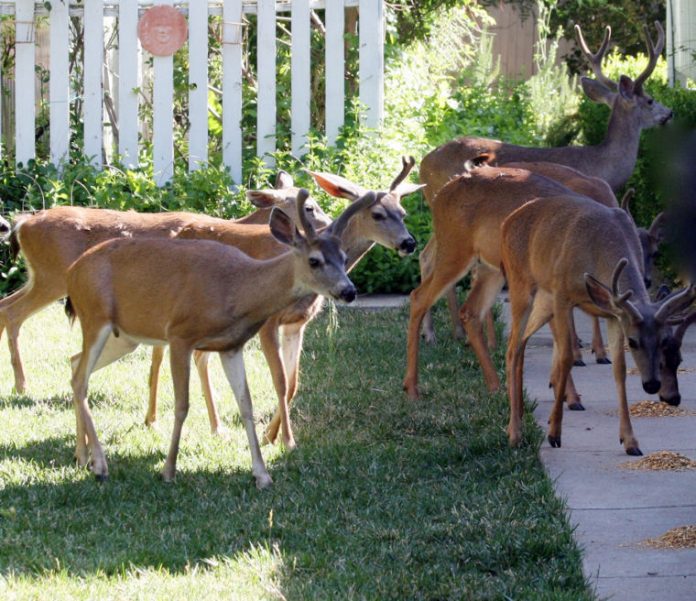Red-winged blackbirds in an oak forest? Gray foxes lounging on a backyard deck? Duck families bobbing in your swimming pool? An influx of seemingly abandoned fawns near homes and businesses?
Wildlife rehabilitators are receiving some unusual calls this year. All of these creatures were found in places you would not expect to find them. The common denominator? The lack of water and consequent scarcity of food.
WERC has received a number of calls like this. Callers want to know, for example, what to do with the apparently abandoned fawn sleeping in the bushes at the edge of their backyard.
Deer are finding themselves in the midst of civilization in their quest for food and water. Mother deer (does) leave fawns in a safe place during the day, while they go off to graze. While does have a scent, fawns do not develop a scent until they are older. Mother leaves her baby alone during the day to avoid attracting a predator, who would likely find the fawn easier prey than the doe. The doe will return to her newborn in the evening.
The best advice is to leave the fawn alone, unless it appears to be ill or injured. If that is the case, our deer consultant will provide advice to the caller.
While many people install high fences, use deer repellent and plant supposedly deer-proof bushes and flowers, others attract them by offering food. Unfortunately, it is illegal to feed most wildlife, including deer. It can also be dangerous, because deer are the primary prey of mountain lions.
To protect livestock from “encroaching” predators such as mountain lions, foxes, coyotes and bobcats, ranchers and farmers should put animals in a barn or other safe area at night. Rural, suburban and even urban dwellers should bring pets and food indoors at night for safekeeping.
Because many of our creeks and ponds have dried up, and the ones that remain are over-crowded, ducks are finding the area around your swimming pool or pond is a great place to lay eggs and raise their ducklings. If you find a pair of ducks exploring your yard, and you don’t want a new family moving in, you can try to scare them away by anchoring Mylar balloons so that they float just above the water line, hanging old CDs above the pool, flying black plastic “flags” or simply waving your arms and shouting. You can also cover the pool.
However, once a nest is built, it is illegal to interfere with the nesting process of native birds. The best you can do is to try to scare them away without harming them. But, if mother duck leaves without taking her ducklings, the ducklings are orphans and cannot survive without her. If she leaves, it is unlikely she’ll return.
The best solution is to allow the family to grow up in the safety in your yard. Put a ramp—which can be as simple as a board covered with toweling (for traction)—leading from the water to the edge of the pool. This will help the ducklings, and any other animals that might fall in, get out of the water. (The downy ducklings are not waterproof like their parents and can drown if they stay too long in the water.) Also be sure that your pool equipment is adjusted so that it does not trap the little ones.
Other creatures are being found in unusual places, too. WERC is located in a hilly area, among many oak trees. In the past few weeks three red-winged blackbirds have taken up residence around the property. These birds normally live in fields, eating seeds, and have never before been seen at the center. They came in search of food and water, which they have found at WERC’s feeders and birdbaths. The news is undoubtedly traveling through the blackbird grapevine and more birds are expected any day.
Remember, as food and water sources dry up, wildlife will move closer to human-inhabited areas. Give our avian friends a little extra support to keep them healthy and happy during this dry season: put bird baths and bird feeders in your yard and keep them filled with fresh water and seed.










